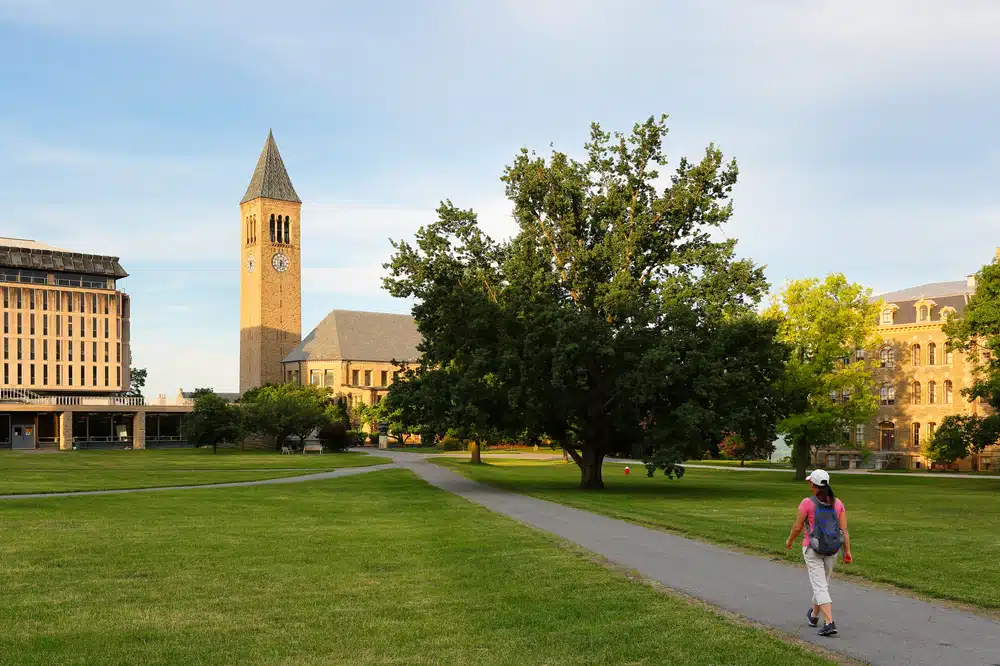Unpacking the Intricacies of Cornell Weather
As the first leaves of autumn begin to color the landscape, one cannot help but marvel at the unique spectacle that is Cornell weather. Nestled in the heart of New York State, Cornell University is a place where the weather is as dynamic and diverse as the student body itself. The changing seasons bring with them a kaleidoscope of weather patterns, each with its own charm and challenges.
From the crisp, cool days of fall to the snow-laden winters, the vibrant springs, and the warm, languid summers, the Cornell weather is a topic of constant discussion, fascination, and sometimes, consternation among its inhabitants. It’s a living, breathing entity that shapes the rhythm of life on campus, influencing everything from daily routines to long-term plans.
Brief Overview of Cornell University and its Location
Cornell University, an Ivy League institution renowned for its academic rigor and diverse programs, is situated in Ithaca, New York.
This location, in the Finger Lakes region, is characterized by its rolling hills, deep gorges, and stunning lakes, offering a picturesque backdrop to the university’s sprawling campus.
However, this idyllic setting is also the stage for a wide range of weather conditions. The Cornell weather is a product of its geographical location, nestled between Lake Ontario to the north and the Appalachian Mountains to the south.
This unique positioning results in a microclimate that is both fascinating and unpredictable, with weather patterns that can change rapidly, often within the same day.
Importance of Understanding the Local Climate and Weather Trends
Understanding the local climate and weather trends is crucial for anyone living in or visiting Cornell.
The weather here is not just a backdrop; it’s an active participant in the life of the university. It influences the choice of clothing, the planning of events, and even the mood on campus.
For instance, the arrival of spring after a long, harsh winter is often met with collective joy and relief, as students flock to Libe Slope to bask in the sun and celebrate the changing season.
Conversely, the onset of winter necessitates preparation and caution, as icy roads and heavy snowfall can pose challenges.
Therefore, keeping a keen eye on Cornell weather forecasts and understanding the local climate’s nuances can greatly enhance one’s experience of this remarkable place.
What makes Cornell weather so unique?
What sets the weather at Cornell apart from other places? Cornell weather is a phenomenon that is as intriguing as it is unpredictable.
It’s a symphony of seasons, each playing its part in the grand orchestra of time. What makes it so unique is the sheer range and rapidity of its changes.
Introduction to Ithaca’s Geographical Location
Ithaca, the home of Cornell University, is a city nestled in the heart of the Finger Lakes region of New York State.
This location is characterized by its deep valleys, rolling hills, and, most notably, its series of long, thin lakes, shaped much like the fingers of a hand.
The city’s geographical position, surrounded by water and hills, plays a significant role in the unique weather patterns experienced here.
The local topography and proximity to large bodies of water contribute to the area’s microclimates, making the Cornell weather a fascinating study of meteorological phenomena.
Discussion on the Influences of the Finger Lakes
The Finger Lakes significantly influence the Cornell weather. These bodies of water serve as vast reservoirs of heat, moderating the local climate.
In the summer, the lakes absorb heat, keeping the surrounding areas cooler, while in the winter, they release stored heat, reducing the severity of the cold.
This phenomenon, known as “lake effect,” also contributes to increased cloud cover and precipitation, especially during the winter months when cold air passes over the warmer lakes, leading to substantial snowfall.
This interaction between land and water creates a unique weather pattern, adding another layer to the complexity of Cornell weather.
Overview of Microclimates and How They Apply to Ithaca and Cornell University
Microclimates are localized climatic conditions that differ from the surrounding areas, often caused by variations in topography, altitude, or proximity to bodies of water.
Ithaca, with its diverse landscape and the presence of the Finger Lakes, is a prime example of a region with multiple microclimates.
These microclimates contribute to the unpredictability and diversity of Cornell weather. For instance, it’s possible for it to be sunny on one part of the campus while another experiences a downpour.
Understanding these microclimates is not just an academic exercise for those studying environmental science or meteorology; it’s a practical necessity for anyone navigating life at Cornell University.
How cold does Cornell get?
What’s the extent of the winter chill at Cornell? On average, winter temperatures in Ithaca, where Cornell University is located, can range from the low 20s to the mid-30s (Fahrenheit) during the day.
At night, temperatures often drop into the teens or even single digits. However, these are just averages, and actual temperatures can vary significantly.
It’s common for Cornell weather to include a few days each winter when the mercury dips below zero.
Wind Chill Factor
When discussing how cold Cornell gets, it’s essential to consider the wind chill factor. Ithaca is known for its windy conditions, especially in the winter months.
The wind can make the already cold temperatures feel even colder, sometimes by as much as 10 to 15 degrees.
This perceived temperature, or “feels like” temperature, is a critical aspect of Cornell weather that everyone on campus learns to respect and prepare for.
Snow and Ice
Another factor contributing to the cold at Cornell is the presence of snow and ice. Ithaca typically receives significant snowfall each winter, with an average of about 65 inches per season.
The snow, along with freezing rain and ice, can make the environment feel colder and require students and staff to bundle up even more.
Variability and Extremes
Finally, it’s worth noting the variability and potential for extremes in Cornell weather. While the averages and typical conditions provide a general idea of how cold it gets, there are always exceptions.
Some winters are milder, while others bring periods of extreme cold that can challenge even the hardiest winter enthusiasts.
Does Cornell get a lot of snow?
Is Cornell known for heavy snowfall? On average, Ithaca receives about 65 inches of snow per year, which is significantly higher than the U.S. average of 28 inches.
This snow typically begins in November and can continue into April, although the heaviest snowfall usually occurs between December and February.
These figures, however, can vary from year to year, with some winters seeing more snow and others less.
Lake Effect Snow
A significant contributor to the amount of snow in Ithaca is the phenomenon known as “lake effect snow.”
This occurs when cold air passes over the warmer waters of the nearby Finger Lakes, picking up moisture and then depositing it as snow when it reaches the land.
This effect can lead to substantial snowfall in a short period, adding to the overall snow totals for Cornell weather.
Impact on Campus Life
The snow at Cornell has a significant impact on campus life. It transforms the landscape into a winter wonderland, providing opportunities for snowball fights, sledding, and other winter activities.
However, it also presents challenges, such as navigating slippery sidewalks and roads. The university is well-equipped to handle these conditions, with regular snow removal operations to keep paths and roads clear.
Variability and Extremes
As with any aspect of weather, there is a degree of variability when it comes to snowfall at Cornell.
Some years may see less snow, while others may experience major snowstorms that result in significant accumulation.
It’s also worth noting that snow can sometimes come unexpectedly early or late in the season, adding to the unpredictability of Cornell weather.
How does Cornell weather impact daily life on campus?
In what ways does the climate influence everyday life on the Cornell campus? Cornell weather is a dynamic and integral part of daily life on campus.
Its unpredictability adds a layer of excitement to the routine of classes, study sessions, and social events.
Effects of Weather on Campus Infrastructure
The diverse Cornell weather also has significant implications for campus infrastructure. The university has robust systems in place to manage the heating needs during the cold winters and cooling requirements in the summer.
Snow removal is another critical aspect, with dedicated teams working tirelessly to clear roads, paths, and parking lots after a snowfall to ensure the safety and accessibility of the campus.
These efforts are crucial in maintaining the smooth operation of the university and minimizing weather-related disruptions to classes and other activities.
Influence of Weather on Student Activities, Sports, and Clubs
Cornell weather plays a significant role in shaping student activities, sports, and clubs. Outdoor sports and activities, in particular, are heavily influenced by the weather.
For instance, the sailing club takes advantage of the windy conditions, while the ski club thrives during the snowy winters.
On the other hand, clubs, and activities may need to adapt to the weather conditions, moving events indoors or rescheduling them as necessary.
Despite these challenges, the weather also provides opportunities for unique experiences, such as ice skating on Beebe Lake in winter or hiking in the gorges in the warmer months.
Personal Experiences and Testimonials from Students
Students often have mixed feelings about Cornell weather. Some relish the snowy winters, enjoying the opportunity to engage in winter sports or simply appreciating the beauty of the snow-covered campus.
Others find the cold and snow challenging, particularly those from warmer climates. However, many students agree that experiencing the four distinct seasons is a unique aspect of studying at Cornell.
The unpredictability of the weather can also lead to memorable experiences, such as unexpected snow days or the joy of a sudden sunny day after a stretch of cloudy weather.
Despite the challenges, many students come to appreciate the Cornell weather for its diversity and the unique rhythm it imparts to campus life.
How can students best prepare for Cornell Weather?
What steps can students take to effectively adapt to the weather at Cornell? Preparing for Cornell weather involves understanding the unique climate of Ithaca and being ready to adapt to its changes.
Essential Clothing and Gear for Different Seasons
Given the diversity of Cornell weather, having the right clothing and gear is crucial. For the cold winters, warm clothing such as thermal layers, waterproof winter boots, a heavy coat, gloves, and a hat are essential.
Snow can be heavy at times, so waterproof gear is recommended. During the fall and spring, layers are key as temperatures can fluctuate throughout the day.
A good raincoat and waterproof shoes are also useful as Ithaca receives a fair amount of rain. For the warmer summer months, light clothing, sunscreen, and a good pair of sunglasses are recommended.
Health and Wellness Tips, Including Dealing with Seasonal Affective Disorder
Cornell weather can also have an impact on health and wellness. During the colder, darker months, some people may experience Seasonal Affective Disorder (SAD), a type of depression that’s related to changes in seasons.
It’s important to recognize the symptoms of SAD, which can include low energy, difficulty concentrating, and changes in appetite or sleep.
If you’re experiencing these symptoms, consider seeking support from Cornell Health or another mental health professional.
Regular exercise, a healthy diet, and staying connected with others can also help to boost mood and overall well-being.
Insider Tips on Navigating Campus During Different Weather Conditions
Navigating the Cornell campus can be a unique experience in different weather conditions. In the winter, be aware that some walkways can be slippery, so take extra care and allow extra time to get to your destination.
Utilize the campus bus system when possible, especially during extreme cold or snow. During warmer weather, take advantage of the beautiful outdoor spaces on campus for studying or relaxing.
Remember, the weather can change quickly, so it’s always a good idea to carry an umbrella or rain jacket just in case.
Despite its challenges, Cornell weather is a fundamental part of the Cornell experience and can be navigated successfully with a little preparation and adaptability.
Conclusion
In conclusion, the Cornell weather, with its unique blend of seasons and unpredictability, is an integral part of life at the university.
It shapes the rhythm of daily activities, influences the campus infrastructure, and even plays a role in the array of student activities.
While it can present challenges, particularly for those unaccustomed to such a diverse climate, it also offers opportunities for unique experiences and personal growth.
From the vibrant colors of fall to the serene beauty of a snow-covered campus, the weather at Cornell is a constant companion, ever-changing, and always fascinating.
Encouragement for Prospective Students
For prospective students considering Cornell, it’s important to see the weather not as a deterrent but as part of the unique charm of the university.
Embracing the Cornell weather means fully experiencing all that the university and the surrounding region have to offer.
It means bundling up for a walk across the snow-laden Arts Quad in winter, enjoying the blossoms in the Botanic Gardens in spring, basking in the sun on Libe Slope in summer, and marveling at the stunning fall foliage in the gorges.
It’s about being part of a community that doesn’t just endure the weather but celebrates it in all its forms.
So, come prepared, stay informed, and get ready to embrace the Cornell weather as a fundamental part of your Cornell experience.
Segue to AdmissionSight
At AdmissionSight, we believe that every student deserves the opportunity to attend the college of their choice. That’s why we specialize in providing expert guidance and support to help you gain acceptance to your top-choice schools.
Our team of college admissions specialists has over a decade of experience assisting students just like you in achieving their goals. We cannot stress this enough; we have the knowledge and expertise to help you succeed.
At AdmissionSight, we pride ourselves on being the most trusted name in college admissions advice. Our success is measured by the success of our students, many of whom have gone on to attend the most prestigious colleges in the country.
Don’t leave your future to chance. Contact AdmissionSight today to schedule a free consultation and take the first step towards achieving your dreams. With our expert guidance and support, anything is possible.










































